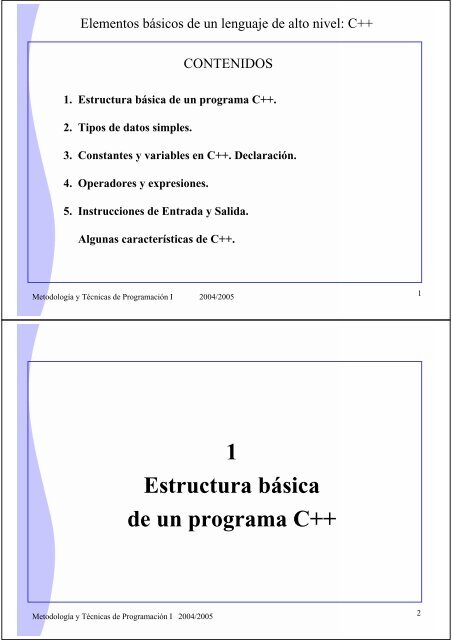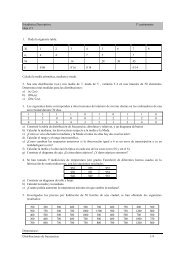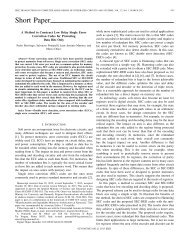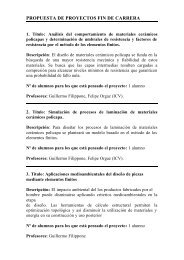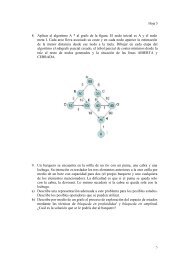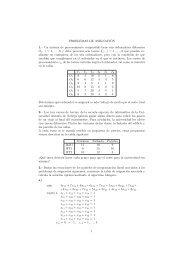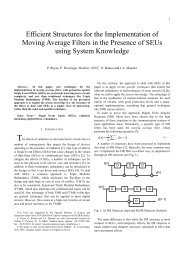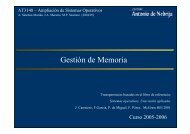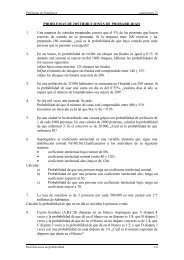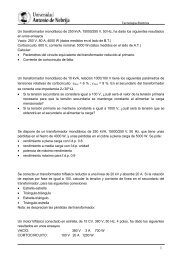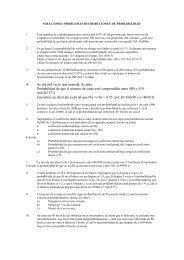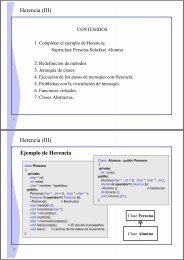1 Estructura básica de un programa C++
1 Estructura básica de un programa C++
1 Estructura básica de un programa C++
You also want an ePaper? Increase the reach of your titles
YUMPU automatically turns print PDFs into web optimized ePapers that Google loves.
Elementos básicos <strong>de</strong> <strong>un</strong> lenguaje <strong>de</strong> alto nivel: <strong>C++</strong><br />
CONTENIDOS<br />
1. <strong>Estructura</strong> <strong>básica</strong> <strong>de</strong> <strong>un</strong> <strong>programa</strong> <strong>C++</strong>.<br />
2. Tipos <strong>de</strong> datos simples.<br />
3. Constantes y variables en <strong>C++</strong>. Declaración.<br />
4. Operadores y expresiones.<br />
5. Instrucciones <strong>de</strong> Entrada y Salida.<br />
Alg<strong>un</strong>as características <strong>de</strong> <strong>C++</strong>.<br />
Metodología y Técnicas <strong>de</strong> Programación I 2004/2005 1<br />
1<br />
<strong>Estructura</strong> <strong>básica</strong><br />
<strong>de</strong> <strong>un</strong> <strong>programa</strong> <strong>C++</strong><br />
Metodología y Técnicas <strong>de</strong> Programación I 2004/2005 2
<strong>Estructura</strong> <strong>de</strong> <strong>un</strong> <strong>programa</strong> <strong>C++</strong><br />
Componente<br />
estructural<br />
básico: la f<strong>un</strong>ción<br />
F<strong>un</strong>ciones<br />
Una <strong>de</strong> las<br />
f<strong>un</strong>ciones ha <strong>de</strong> ser<br />
main<br />
Directivas <strong>de</strong> preprocesador<br />
Declaraciones globales ( varaibles globales, f<strong>un</strong>ciones, …)<br />
f<strong>un</strong>ción main()<br />
{<br />
secuencia <strong>de</strong> <strong>de</strong>claraciones e instrucciones<br />
}<br />
f<strong>un</strong>ción1()<br />
{<br />
secuencia <strong>de</strong> <strong>de</strong>claraciones e instrucciones<br />
}<br />
...<br />
f<strong>un</strong>ciónN()<br />
{<br />
secuencia <strong>de</strong> <strong>de</strong>claraciones e instrucciones<br />
}<br />
Metodología y Técnicas <strong>de</strong> Programación I 2004/2005 3<br />
<strong>Estructura</strong> <strong>de</strong> <strong>un</strong> <strong>programa</strong> <strong>C++</strong><br />
Un ejemplo sencillo <strong>de</strong> <strong>un</strong> <strong>programa</strong> que intercambia el valor <strong>de</strong> 2 números:<br />
Directiva <strong>de</strong> preprocesamiento Biblioteca <strong>de</strong> E/S por consola<br />
Este <strong>programa</strong> usa la <strong>de</strong>finición <strong>de</strong><br />
cout para escribir por consola<br />
#inclu<strong>de</strong> <br />
int main()<br />
{<br />
int x, y;<br />
int aux;<br />
cin >> x >> y;<br />
aux = x;<br />
x = y;<br />
y = aux;<br />
cout
<strong>Estructura</strong> <strong>de</strong> <strong>un</strong> <strong>programa</strong> <strong>C++</strong><br />
Un ejemplo sencillo <strong>de</strong> <strong>un</strong> <strong>programa</strong> que intercambia el valor <strong>de</strong> 2 números:<br />
#inclu<strong>de</strong> <br />
int main()<br />
{<br />
int x, y;<br />
int aux;<br />
}<br />
cin >> x >> y;<br />
aux = x;<br />
x = y;<br />
y = aux;<br />
cout
<strong>Estructura</strong> <strong>de</strong> <strong>un</strong> <strong>programa</strong> <strong>C++</strong><br />
Directivas <strong>de</strong>l preprocesador<br />
#inclu<strong>de</strong> <br />
int main()<br />
{<br />
cout
<strong>Estructura</strong> <strong>de</strong> <strong>un</strong> <strong>programa</strong> <strong>C++</strong><br />
La f<strong>un</strong>ción main()<br />
Una f<strong>un</strong>ción <strong>C++</strong> es <strong>un</strong> sub<strong>programa</strong> que <strong>de</strong>vuelve <strong>un</strong> valor, <strong>un</strong> conj<strong>un</strong>to<br />
<strong>de</strong> valores o realiza <strong>un</strong>a tarea específica.<br />
Todo <strong>programa</strong> <strong>C++</strong> tiene <strong>un</strong>a única f<strong>un</strong>ción main() que es el p<strong>un</strong>to<br />
inicial <strong>de</strong> entrada al <strong>programa</strong>.<br />
Las sentencias escritas entre las<br />
llaves se <strong>de</strong>nomina BLOQUE<br />
#inclu<strong>de</strong> <br />
main()<br />
{<br />
…<br />
...<br />
}<br />
Si se intenta <strong>de</strong>clarar dos f<strong>un</strong>ciones<br />
Llamadas a<br />
otras f<strong>un</strong>ciones<br />
main() <strong>de</strong>ntro <strong>de</strong>l <strong>programa</strong> se produce error.<br />
#inclu<strong>de</strong> <br />
int main()<br />
{<br />
entrada_datos();<br />
proceso_datos();<br />
return 0;<br />
...<br />
}<br />
Metodología y Técnicas <strong>de</strong> Programación I 2004/2005 9<br />
<strong>Estructura</strong> <strong>de</strong> <strong>un</strong> <strong>programa</strong> <strong>C++</strong><br />
Comentarios<br />
Un comentario es cualquier información que se escribe el en <strong>programa</strong><br />
para proporcionar información <strong>de</strong> cualquier tipo.<br />
#inclu<strong>de</strong> <br />
/* po<strong>de</strong>mos hacer<br />
comentarios que ocupen<br />
varias líneas */<br />
int main()<br />
{<br />
int x, y;<br />
int aux; // éste es <strong>un</strong> comentario <strong>de</strong> <strong>un</strong>a sola línea<br />
cin >> x >> y;<br />
...<br />
return 0;<br />
}<br />
Po<strong>de</strong>mos escribir los<br />
comentarios <strong>de</strong> dos<br />
formas diferentes<br />
Metodología y Técnicas <strong>de</strong> Programación I 2004/2005 10
2<br />
Tipos <strong>de</strong> datos simples<br />
Metodología y Técnicas <strong>de</strong> Programación I 2004/2005 11<br />
Tipos <strong>de</strong> datos básicos en <strong>C++</strong><br />
El tipo <strong>de</strong> dato <strong>de</strong>termina la naturaleza <strong>de</strong>l valor que pue<strong>de</strong> tomar <strong>un</strong>a<br />
variable.Un tipo <strong>de</strong> dato <strong>de</strong>fine <strong>un</strong> dominio <strong>de</strong> valores y las operaciones<br />
que se pue<strong>de</strong>n realizar con éstos valores.<br />
<strong>C++</strong> dispone <strong>de</strong> <strong>un</strong>os cuantos tipos <strong>de</strong> datos pre<strong>de</strong>finidos (simples) y permite<br />
al <strong>programa</strong>dor crear otros tipos <strong>de</strong> datos<br />
Tipo <strong>de</strong> datos básicos<br />
• int ( Números enteros )<br />
• float ( Números reales )<br />
• double ( Números reales más gran<strong>de</strong>s que float )<br />
• bool ( Valores lógicos )<br />
• char ( Caracteres y cualquier cantidad <strong>de</strong> 8 bits )<br />
• void ( Nada. Sirve para indicar que <strong>un</strong>a fonción no <strong>de</strong>vuelve valores )<br />
Metodología y Técnicas <strong>de</strong> Programación I 2004/2005 12
Tipos <strong>de</strong> datos básicos en <strong>C++</strong><br />
Tipo int<br />
Tamaño en bytes: 2 bytes (16 bits)<br />
Dominio: son todos los números enteros entre los valores<br />
-32.768 y 32.767<br />
Operaciones:<br />
+ Suma<br />
int × int → int<br />
- Resta<br />
* Producto<br />
/ División entera<br />
% Resto <strong>de</strong> la división entera<br />
(módulo)<br />
- , + Signo negativo, positivo<br />
++ Incrementación<br />
-- Decrementación int → int<br />
Números enteros<br />
Prioridad <strong>de</strong> los<br />
operadores:<br />
++, - - 10*5++<br />
- , + (<strong>un</strong>ario) -3<br />
* , /, % 3*5<br />
+, - 6+7<br />
10×6<br />
Metodología y Técnicas <strong>de</strong> Programación I 2004/2005 13<br />
Tipos <strong>de</strong> datos básicos en <strong>C++</strong><br />
Operadores <strong>de</strong> incrementación y <strong>de</strong>crementación<br />
Son equivalentes<br />
m = m + 1;<br />
m++;<br />
++m;<br />
Se trata <strong>de</strong> los operadores: ++ - -<br />
x = 10;<br />
y = x++; // y vale 10<br />
Suma <strong>un</strong>a <strong>un</strong>idad<br />
a su argumento<br />
Resta <strong>un</strong>a <strong>un</strong>idad<br />
a su argumento<br />
Si prece<strong>de</strong> al operando, se realiza la operación ++<br />
o -- y luego se realiza la asignación.<br />
x = 10;<br />
y = ++x; // y vale 11<br />
Si sigue al operando, se realiza la asignación y<br />
posteriormente se realiza la operación ++ o --<br />
Metodología y Técnicas <strong>de</strong> Programación I 2004/2005 14
Tipos <strong>de</strong> datos básicos en <strong>C++</strong><br />
Tipo float<br />
Tamaño en bytes: 4 bytes<br />
Dominio: son todos los números reales que contienen <strong>un</strong>a coma <strong>de</strong>cimal<br />
comprendidos entre los valores:<br />
Operaciones:<br />
3,4 × 10 -38 y 3,4 × 10 38<br />
+ Suma<br />
float × float → float<br />
- Resta<br />
* Producto<br />
/ División en coma flotante<br />
- , + Signo negativo, positivo<br />
++ Incrementación<br />
-- Decrementación float → float<br />
Números reales<br />
La prioridad <strong>de</strong> los<br />
operadores es la misma<br />
que para el tipo int<br />
Metodología y Técnicas <strong>de</strong> Programación I 2004/2005 15<br />
Tipos <strong>de</strong> datos básicos en <strong>C++</strong><br />
Tipo double<br />
Tamaño en bytes: 8 bytes<br />
Números reales<br />
Dominio: son todos los números reales que contienen <strong>un</strong>a coma <strong>de</strong>cimal<br />
comprendidos entre los valores:<br />
Operaciones:<br />
1,7 × 10 -308 y 1,7 × 10 308<br />
+ Suma<br />
double × double → double<br />
- Resta<br />
* Producto<br />
/ División en coma flotante<br />
- , + Signo negativo, positivo<br />
++ Incrementación<br />
-- Decrementación double → double<br />
Igual que float pero más gran<strong>de</strong>s<br />
La prioridad <strong>de</strong> los<br />
operadores es la misma<br />
que para el tipo int<br />
Metodología y Técnicas <strong>de</strong> Programación I 2004/2005 16
Tipos <strong>de</strong> datos básicos en <strong>C++</strong><br />
A<strong>de</strong>más <strong>de</strong> éstas operaciones, <strong>C++</strong> dispone <strong>de</strong> <strong>un</strong> gran conj<strong>un</strong>to <strong>de</strong><br />
f<strong>un</strong>ciones matemáticas.<br />
F<strong>un</strong>ciones:<br />
abs: int → int Calcula el valor absoluto <strong>de</strong> <strong>un</strong> número<br />
ceil: double → double Calcula el número entero mayor o igual que el dado<br />
floor: double → double Redon<strong>de</strong>a por <strong>de</strong>fecto el valor <strong>de</strong> <strong>un</strong> número<br />
fmod: double × double → double Calcula el resto <strong>de</strong> la división real <strong>de</strong> dos números<br />
sqrt: double → double Calcula la raíz cuadrada <strong>de</strong> <strong>un</strong> número<br />
#inclu<strong>de</strong> <br />
{<br />
x = abs(-7) // x vale 7<br />
y = ceil (5.2) // y vale 6<br />
z = floor (5.2) // z vale 5<br />
resto = fmod(5.0, 2.0) // resto vale 1<br />
}<br />
Los archivos <strong>de</strong> cabecera que<br />
contienen éstas f<strong>un</strong>ciones son<br />
entre otras:<br />
math.h<br />
float.h<br />
complex.h<br />
Metodología y Técnicas <strong>de</strong> Programación I 2004/2005 17<br />
Tipos <strong>de</strong> datos básicos en <strong>C++</strong><br />
Tipo bool<br />
Tamaño en bytes: 1 byte<br />
Dominio: dos únicos valores: { true, false }<br />
No todos los compiladores <strong>de</strong> <strong>C++</strong> tienen éste tipo <strong>de</strong> dato. En su lugar se utiliza el tipo int<br />
para representar el tipo <strong>de</strong> datos bool, <strong>de</strong> forma que el valor entero 0 representa false y<br />
cualquier otro valor representa true.<br />
Operaciones:<br />
&& Y lógica (and)<br />
|| O lógica (or)<br />
Falso → Cero<br />
Verda<strong>de</strong>ro → Distinto <strong>de</strong> cero<br />
! Negación lógica (not)<br />
bool × bool → bool<br />
bool → bool<br />
Operadores lógicos<br />
Prioridad <strong>de</strong><br />
los operadores<br />
!<br />
&&, ||
Tipos <strong>de</strong> datos básicos en <strong>C++</strong><br />
Tabla <strong>de</strong> verdad:<br />
A B ! A A && B A || B<br />
T T F T T<br />
T F F F T<br />
F T T F T<br />
F F T F F<br />
Operadores relacionales:<br />
= = Igual a<br />
!= Distinto<br />
> Mayor que<br />
< Menor que<br />
>= Mayor o igual que<br />
Tipos <strong>de</strong> datos básicos en <strong>C++</strong><br />
Tipo char<br />
Tamaño en bytes: 1 byte<br />
Dominio: dígitos, letras mayúsculas, letras minúsculas y signos <strong>de</strong><br />
p<strong>un</strong>tuación.<br />
Internamente, los caracteres se almacenan como números. El tipo char<br />
representa valores en el rango -128 y 127 y se asocian con el código<br />
ASCII. Así, el carácter ‘A’ se almacena como el número 65, etc ...<br />
0 < 1 < 2 …. < 9 < A < B < … < Z < a < b < …< z<br />
Metodología y Técnicas <strong>de</strong> Programación I 2004/2005 21<br />
Tipos <strong>de</strong> datos básicos en <strong>C++</strong><br />
Operaciones:<br />
Dado que los caracteres se almacenan internamente como números<br />
enteros, se pue<strong>de</strong>n realizar operaciones aritméticas con los datos <strong>de</strong> tipo<br />
char. Se pue<strong>de</strong> sumar <strong>un</strong> entero a <strong>un</strong> carácter para obtener otro código<br />
ASCII diferente.<br />
Ejemplos:<br />
Más a<strong>de</strong>lante veremos que, en <strong>un</strong>ión<br />
con la estructura array, se pue<strong>de</strong>n almacenar<br />
ca<strong>de</strong>nas <strong>de</strong> caracteres.<br />
Para convertir <strong>un</strong>a letra minúscula en mayúscula basta con restar 32.<br />
‘a’ - 32 = ‘A’<br />
Para convertir <strong>un</strong>a letra mayúscula en minúscula basta con sumar 32.<br />
‘B’ + 32 = ‘b’<br />
Para convertir el carácter ‘4’ en el número 4 basta con restar 48.<br />
‘4’ - 48 = 4<br />
Metodología y Técnicas <strong>de</strong> Programación I 2004/2005 22
Tipos <strong>de</strong> datos básicos en <strong>C++</strong><br />
F<strong>un</strong>ciones:<br />
isdigit: char → int Devuelve TRUE si el carácter es: ‘0’, … ,‘9’<br />
isalpha: char → int Devuelve TRUE si el carácter es: ‘A’, … ,‘Z’, ‘a’, … , ‘z’.<br />
islower: char → int Devuelve TRUE si el carácter es <strong>un</strong>a letra minúscula: ‘a’, … , ‘z’.<br />
isupper: char → int Devuelve TRUE si el carácter es <strong>un</strong>a letra mayúscula: ‘A’, … , ‘Z’.<br />
tolower: char → char Convierte <strong>un</strong> carácter mayúscula en minúscula.<br />
toupper: char → char Convierte <strong>un</strong> carácter minúscula en mayúscula.<br />
#inclu<strong>de</strong> <br />
char c = 65;<br />
{<br />
...<br />
char c = ‘A’;<br />
c = tolower (c); // c vale ‘a’<br />
t = isdigit(c) ; // t vale O (FALSE)<br />
...<br />
}<br />
El archivo <strong>de</strong> cabecera que<br />
contiene éstas f<strong>un</strong>ciones es:<br />
ctype.h<br />
Metodología y Técnicas <strong>de</strong> Programación I 2004/2005 23<br />
Tipos <strong>de</strong> datos básicos en <strong>C++</strong><br />
Modificadores <strong>de</strong> tipos <strong>de</strong> datos<br />
Los tipos <strong>de</strong> datos int, double y char tienen variaciones o modificadores<br />
<strong>de</strong> tipos <strong>de</strong> datos.<br />
Permiten <strong>un</strong> uso más eficiente<br />
Son modificadores los siguientes:<br />
<strong>de</strong> los tipos <strong>de</strong> datos<br />
signed <strong>un</strong>signed<br />
short log<br />
Rango <strong>de</strong> valores<br />
<strong>un</strong>signed int 0 …65625<br />
long double -3,37 × 10 -4932 … 3,37 × 10 4932<br />
long int -2147483648 … 2147483647<br />
Metodología y Técnicas <strong>de</strong> Programación I 2004/2005 24
Tipos <strong>de</strong> datos básicos en <strong>C++</strong><br />
Las computadoras realizan numerosas operaciones para la resolución <strong>de</strong><br />
problemas,<br />
- Operaciones aritméticas y lógicas.<br />
- Operaciones condicionales.<br />
...<br />
A<strong>de</strong>más, pue<strong>de</strong> ocurrir que en <strong>un</strong>a misma expresión concurran varios tipos<br />
<strong>de</strong> datos. Ante ésta situación, <strong>de</strong>bemos saber cómo se comporta el<br />
compilador.<br />
Cuando los dos operandos son <strong>de</strong><br />
tipos distintos, el <strong>de</strong> tipo menor se<br />
promociona<br />
al <strong>de</strong> tipo mayor.<br />
long double<br />
double<br />
float<br />
int<br />
short int<br />
char<br />
Tipos <strong>de</strong> mayor<br />
a menor<br />
Metodología y Técnicas <strong>de</strong> Programación I 2004/2005 25<br />
Tipos <strong>de</strong> datos básicos en <strong>C++</strong><br />
En cuanto a la memoria que<br />
ocupa cada tipo:<br />
Esto no siempre es cierto,<br />
<strong>de</strong>pen<strong>de</strong> <strong>de</strong>l or<strong>de</strong>nador y<br />
<strong>de</strong>l compilador.<br />
Tipo <strong>de</strong><br />
datos<br />
Datos<br />
almacenados<br />
Metodología y Técnicas <strong>de</strong> Programación I 2004/2005 26<br />
+<br />
-<br />
#inclu<strong>de</strong> <br />
#inclu<strong>de</strong> <br />
int main()<br />
{<br />
int i;<br />
i = sizeof( int )*8;<br />
}<br />
cout
3<br />
Constantes y variables <strong>C++</strong><br />
Metodología y Técnicas <strong>de</strong> Programación I 2004/2005 27<br />
Constantes y Variables<br />
• Son porciones <strong>de</strong> memoria que almacenan <strong>un</strong> valor.<br />
• Las variables son palabras que manipulan datos. Dicho valor pue<strong>de</strong> ser<br />
modificado en cualquier momento durante la ejecución <strong>de</strong>l <strong>programa</strong>.<br />
• Una constante es <strong>un</strong>a variable cuyo valor no pue<strong>de</strong> ser modificado.<br />
• Las variables pue<strong>de</strong>n almacenar todo tipo <strong>de</strong> datos: caracteres, números,<br />
estructuras, etc … Dependiendo <strong>de</strong>l valor <strong>de</strong> la variable, <strong>de</strong>cimos que dicha<br />
variable es <strong>de</strong> <strong>un</strong> tipo <strong>de</strong> dato.<br />
• Tanto las variables como las constantes están constituidas por <strong>un</strong> nombre y <strong>un</strong><br />
valor. El nombre lo llamaremos i<strong>de</strong>ntificador.<br />
Toda variable utilizada en <strong>un</strong> <strong>programa</strong> <strong>de</strong>be ser <strong>de</strong>clarada previamente. En<br />
<strong>C++</strong>, ésta <strong>de</strong>claración pue<strong>de</strong> situarse en cualquier parte <strong>de</strong>l <strong>programa</strong>.<br />
Dependiendo <strong>de</strong> dón<strong>de</strong> se <strong>de</strong>finan,<br />
tenemos varios tipos:<br />
Variables globales<br />
Variables locales<br />
Parámetros<br />
Metodología y Técnicas <strong>de</strong> Programación I 2004/2005 28
Constantes y Variables<br />
Declaración <strong>de</strong> variables<br />
La <strong>de</strong>claración <strong>de</strong> <strong>un</strong>a variable consiste en escribir <strong>un</strong> sentencia que<br />
proporciona información al compilador <strong>de</strong> <strong>C++</strong>.<br />
• El compilador reserva <strong>un</strong> espacio <strong>de</strong> almacenamiento en memoria.<br />
• Los nombres <strong>de</strong> las variables se suelen<br />
escribir en minúsculas.<br />
En <strong>C++</strong> las variables no se<br />
actualizan automáticamente<br />
El procedimiento para <strong>de</strong>clarar <strong>un</strong>a variable:<br />
;<br />
;<br />
= valor;<br />
int x;<br />
char x, y, z;<br />
long int i =10, j, k=0;<br />
Metodología y Técnicas <strong>de</strong> Programación I 2004/2005 29<br />
Constantes y Variables<br />
Una forma <strong>de</strong> expresar el procedimiento para <strong>de</strong>clarar <strong>un</strong>a variable es<br />
mediante los diagramas sintácticos:<br />
Declaración <strong>de</strong> variables<br />
Tipo <strong>de</strong> dato Nombre_<strong>de</strong>_variable<br />
=<br />
Valor_inicial<br />
Declaraciones locales<br />
Son variables locales aquellas que están <strong>de</strong>claradas <strong>de</strong>ntro <strong>de</strong> las<br />
f<strong>un</strong>ciones o <strong>de</strong> los bloques.<br />
Metodología y Técnicas <strong>de</strong> Programación I 2004/2005 30<br />
,<br />
;
Constantes y Variables<br />
Declaraciones globales ( variables globales, f<strong>un</strong>ciones, …)<br />
La zona <strong>de</strong> <strong>de</strong>claraciones globales <strong>de</strong> <strong>un</strong> <strong>programa</strong> pue<strong>de</strong> incluir<br />
<strong>de</strong>claraciones <strong>de</strong> variables y <strong>de</strong>claraciones <strong>de</strong> f<strong>un</strong>ciones (prototipos).<br />
Las f<strong>un</strong>ciones y variables<br />
aquí <strong>de</strong>claradas, se pue<strong>de</strong>n<br />
utilizar en cualquier p<strong>un</strong>to<br />
<strong>de</strong>l <strong>programa</strong>.<br />
Parámetros<br />
Definidos en la lista <strong>de</strong> parámetros<br />
formales <strong>de</strong> las f<strong>un</strong>ciones.<br />
Metodología y Técnicas <strong>de</strong> Programación I 2004/2005 31<br />
Constantes y Variables<br />
Ejemplos:<br />
…<br />
int f<strong>un</strong>cion1()<br />
{<br />
int i;<br />
if ( i= =1)<br />
{<br />
char m=‘s’;<br />
….<br />
}<br />
}<br />
...<br />
Variables locales<br />
/* aquí no se conoce a m */<br />
La variable m solo<br />
existe en éste bloque<br />
Metodología y Técnicas <strong>de</strong> Programación I 2004/2005 32<br />
…<br />
int calcular(int i, float j)<br />
{<br />
...<br />
}<br />
...<br />
Parámetros
Constantes y Variables<br />
Declaración <strong>de</strong> Constantes<br />
Una constante es <strong>un</strong>a variable cuyo valor no pue<strong>de</strong> ser modificado.<br />
Los nombres <strong>de</strong> las constantes se suelen escribir en mayúsculas.<br />
1. Constantes <strong>de</strong>claradas const<br />
La palabra reservada const es <strong>un</strong> calificador <strong>de</strong> tipo variable e indica que el valor<br />
<strong>de</strong> variable no se pue<strong>de</strong> modificar.<br />
const = ;<br />
…<br />
const int DIAS = 7;<br />
const char VACIO = ‘ ‘;<br />
const char PORCENTAJE = ‘% ‘;<br />
...<br />
Ejemplos<br />
Si se intenta modificar <strong>un</strong>a variable<br />
<strong>de</strong>finida con const, se produce error.<br />
Metodología y Técnicas <strong>de</strong> Programación I 2004/2005 33<br />
Constantes y Variables<br />
2. Constantes <strong>de</strong>finidas<br />
Se <strong>de</strong>claran mediante la directiva #<strong>de</strong>fine<br />
#<strong>de</strong>fine <br />
Ejemplos<br />
…<br />
#<strong>de</strong>fine pi 3.14<br />
#<strong>de</strong>fine fin ‘F’<br />
...<br />
No se especifica<br />
el tipo <strong>de</strong> dato<br />
No aparece ;<br />
al final <strong>de</strong> la sentencia<br />
No aparece el<br />
símbolo =<br />
Es más recomendable utilizar const en lugar <strong>de</strong> #<strong>de</strong>fine ya que el compilador<br />
genera código más eficiente.<br />
Metodología y Técnicas <strong>de</strong> Programación I 2004/2005 34
Constantes y Variables<br />
3. Constantes enumeradas<br />
Las constantes enumeradas permiten crear listas <strong>de</strong> elementos afines.<br />
Ejemplo <strong>de</strong> constante enumerada<br />
<strong>de</strong> <strong>un</strong>a lista <strong>de</strong> colores<br />
…<br />
enum Colores {Rojo, Ver<strong>de</strong>, Azul, Amarillo};<br />
enum Botones {Salir, Jugar};<br />
…<br />
Colores favorito = Rojo;<br />
…<br />
enum { };<br />
Se comporta como<br />
cualquier otro tipo <strong>de</strong><br />
datos.<br />
Se pue<strong>de</strong>n <strong>de</strong>clarar<br />
variables <strong>de</strong> tipo<br />
enumerado.<br />
El compilador asigna <strong>un</strong> número a cada elemento <strong>de</strong>l conj<strong>un</strong>to (comenzando con 0).<br />
Metodología y Técnicas <strong>de</strong> Programación I 2004/2005 35<br />
Constantes y Variables<br />
Ejemplo <strong>de</strong>l f<strong>un</strong>cionamiento <strong>de</strong> enumeraciones<br />
#inclu<strong>de</strong> <br />
int main()<br />
{<br />
enum Dias { L<strong>un</strong>es, Martes, Miercoles, Jueves, Viernes };<br />
Dias libre = Viernes; // Dias libre = 4;<br />
cout
4<br />
Operadores y expresiones<br />
Metodología y Técnicas <strong>de</strong> Programación I 2004/2005 37<br />
Operadores y Expresiones<br />
1. Instrucciones <strong>de</strong> asignación.<br />
= ;<br />
Pue<strong>de</strong> ser otra variable, <strong>un</strong>a constante o <strong>un</strong>a operación<br />
entre variables y constantes.<br />
El operador asignación (=) asigna el valor <strong>de</strong> la expresión <strong>de</strong>recha a la<br />
variable situada en la izquierda <strong>de</strong> la instrucción.<br />
Po<strong>de</strong>mos tener en <strong>C++</strong> varios operadores <strong>de</strong> asignación:<br />
= += -= *= /= %=<br />
Metodología y Técnicas <strong>de</strong> Programación I 2004/2005 38
Operadores y Expresiones<br />
Ejemplos:<br />
m += n;<br />
m -= n;<br />
m *= n;<br />
m /= n;<br />
m %= n;<br />
m = n; // asigna el valor <strong>de</strong> n a m<br />
m = m + n; //suma m y n y lo asigna a la variable m<br />
m = m- n; // resta m menos n y lo asigna a la variable m<br />
m = m * n; //multiplica m por n y lo asigna a la variable m<br />
m = m / n; //divi<strong>de</strong> m entre n y lo asigna a la variable m<br />
m = m % n; //calcula el resto <strong>de</strong> la div. entera y lo asigna a la variable m<br />
Instrucción abreviada.<br />
Metodología y Técnicas <strong>de</strong> Programación I 2004/2005 39<br />
Operadores y Expresiones<br />
Más ejemplos:<br />
Po<strong>de</strong>mos dar valores a varias variables a la vez<br />
m = n = t = 10; // Damos a las variables m, n y t el valor 10<br />
m = n = t = a; // las variables m, n y t toman el valor <strong>de</strong> la variable a<br />
También po<strong>de</strong>mos asignar a varias variables el valor <strong>de</strong> otra <strong>de</strong> <strong>un</strong> sólo golpe<br />
Metodología y Técnicas <strong>de</strong> Programación I 2004/2005 40
Operadores y Expresiones<br />
2. Operador <strong>de</strong> dirección: &<br />
999<br />
998<br />
997<br />
2<br />
1<br />
0<br />
Cuando se <strong>de</strong>clara <strong>un</strong>a variable, se le asocian tres características:<br />
1000001 x<br />
1001111<br />
0000001<br />
- nombre <strong>de</strong> la variable<br />
- tipo <strong>de</strong> la variable<br />
- dirección <strong>de</strong> memoria<br />
…<br />
char x = ‘A’;<br />
…<br />
El valor <strong>de</strong> la variable x es ‘A’.<br />
La dirección <strong>de</strong> memoria es 2.<br />
Para conocer la dirección <strong>de</strong> memoria don<strong>de</strong> se encuentra<br />
almacenada la variable, se pue<strong>de</strong> utilizar el operador &.<br />
…<br />
cout
5<br />
Instrucciones <strong>de</strong><br />
Entrada / Salida<br />
Metodología y Técnicas <strong>de</strong> Programación I 2004/2005 43<br />
Instrucciones <strong>de</strong> Entrada / Salida<br />
En <strong>C++</strong> la entrada y salida se lee y escribe en flujos. Cuando se incluye la<br />
biblioteca iostream.h en el <strong>programa</strong>, se <strong>de</strong>finen automáticamente dos flujos:<br />
Flujo cin (se utiliza para la entrada <strong>de</strong> datos)<br />
Flujo cout (se utiliza para la salida <strong>de</strong> datos)<br />
Permiten la com<strong>un</strong>icación <strong>de</strong>l<br />
or<strong>de</strong>nador con el exterior para<br />
tomar datos o <strong>de</strong>volver resultados<br />
Esta biblioteca también nos proporciona dos operadores, <strong>un</strong>o <strong>de</strong> inserción ( ) para<br />
extraer valores <strong>de</strong>l flujo cin y almacenarlos en variables.<br />
…<br />
cin >> a;<br />
cin >> a >> b >> c;<br />
…<br />
…<br />
cout
Instrucciones <strong>de</strong> Entrada / Salida<br />
<strong>C++</strong> utiliza secuencias <strong>de</strong> escape para visualizar caracteres que no están<br />
representados por los símbolos tradicionales.<br />
Las más utilizadas las mostramos en la siguiente tabla:<br />
\n Retorno <strong>de</strong> carro y avance <strong>de</strong> línea<br />
\t Tabulación<br />
\a Alarma<br />
\” Dobles comillas<br />
\\ Barra inclinada<br />
…<br />
cout


